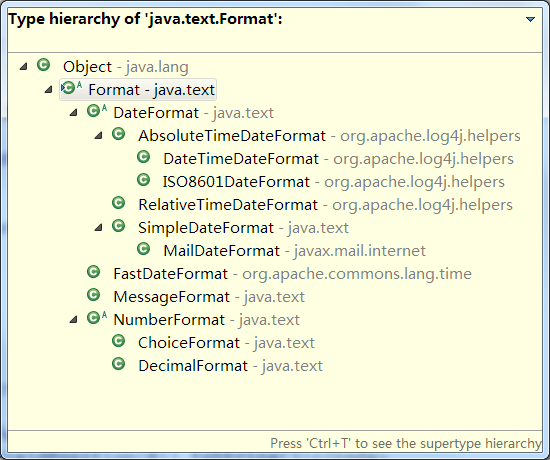MessageFormat.format()用法
1.java.text.Format的继承结构如下
FormatElement
{ ArgumentIndex }:是从0开始的入参位置索引
{ ArgumentIndex , FormatType }
{ ArgumentIndex , FormatType , FormatStyle }
FormatType:指定使用不同的Format子类对入参进行格式化处理。值范围如下:
number:调用NumberFormat进行格式化
date:调用DateFormat进行格式化
time:调用DateFormat进行格式化
choice:调用ChoiceFormat进行格式化
FormatStyle:设置FormatType中使用的格式化样式。值范围如下:
short、medium、long、full、integer、currency、percent、SubformatPattern (子格式模式,形如#.##)
还以str为例,在这个字符串中:
1、{0}和{1,number,short}和{2,number,#.#};都属于FormatElement,0,1,2是ArgumentIndex。
2、{1,number,short}里面的number属于FormatType,short则属于FormatStyle。
3、{1,number,#.#}里面的#.#就属于子格式模式。
指定FormatType和FormatStyle是为了生成日期格式的值、不同精度的数字、百分比类型等等。
1、ArgumentIndex必须是非负整数,它的个数不只限于0到9这10个,它可以用0到9的数字组成,因此可以有好多个,如:
2、格式化字符串时,两个单引号才表示一个单引号,单个单引号会被省略,除非中文单引号不会被省略,如:
给字母a加上单引号,如:如果需要显示双引号要进行转移,比如:String msg = "oh, {0} is \"a\" pig";
3、单引号会使其后面的占位符均失效,导致直接输出占位符。
使用双引号和两个单引号没有关系,比如
又比如,使用子格式模式,多了一个单引号:
3、无论是有引号字符串还是无引号字符串,左花括号都是不支持的,如:
如果使用左花括号会出现异常
因此要使用到左花括号需要使用单引号配合使用
还有一个有趣的现象,如果出现两个或2个以上左花括号,就会出现分割字符串,但是右花括号就没问题,虽然没有任何意义,实际应用我们也用不到MessageFormat.format("'{'{0}}", "X-rapido"); // {X-rapido}
关于MessageFormat.format方法:
每调用一次MessageFormat.format方法,都会新创建MessageFormat的一个实例,相当于MessageFormat只使用了一次。MessageFormat类的format方法如下:
因此若要多次格式同一个模式的字符串,那么创建一个MessageFormat实例在执行格式化操作比较好些



